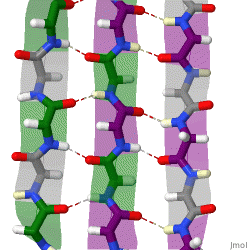|
Coot (program)
The program Coot (Crystallographic Object-Oriented Toolkit) is used to display and manipulate atomic models of macromolecules, typically of proteins or nucleic acids, using 3D computer graphics. It is primarily focused on building and validation of atomic models into three-dimensional Resolution (electron density), electron density maps obtained by X-ray crystallography methods, although it has also been applied to data from electron microscopy. Overview Coot displays electron density maps and atomic models and allows model manipulations such as idealization, real space refinement, manual rotation/translation, rigid-body fitting, ligand search, solvation, mutations, rotamers, and Ramachandran plot, Ramachandran idealization. The software is designed to be easy-to-learn for novice users, achieved by ensuring that tools for common tasks are 'discoverable' through familiar user interface elements (menus and toolbars), or by intuitive behaviour (mouse controls). Recent developments hav ... [...More Info...] [...Related Items...] OR: [Wikipedia] [Google] [Baidu] |
Paul Emsley (crystallographer)
Paul Emsley is a British crystallography, crystallographer at the Laboratory of Molecular Biology, MRC Laboratory of Molecular Biology in Cambridge. He works as an independent scientist and is a member of the Computational Crystallography Group headed by Garib Murshudov. Emsley is the primary author of the model-building software Coot (software), Coot,Emsley, P., Lohkamp, B., Scott, W.G. and Cowtan, K., 2010Features and development of Coot ''Acta Crystallographica Section D'', ''66''(4), pp.486-501. a tool for building models of proteins whose three dimensional structures are determined via X-ray crystallography or Cryo-electron microscopy, cryo-EM. These protein structures are deposited at the Worldwide Protein Data Bank for collaboration among scientists. Since its introduction in 2004, Coot has remained as free software for use in industrial and academic research groups. Emsley has given lectures and tutorials on model-building and validation at Cold Spring Harbor Laboratory an ... [...More Info...] [...Related Items...] OR: [Wikipedia] [Google] [Baidu] |
University Of California At Santa Cruz
The University of California, Santa Cruz (UC Santa Cruz or UCSC) is a public land-grant research university in Santa Cruz, California, United States. It is one of the ten campuses in the University of California system. Located in Monterey Bay, on the edge of the coastal community of Santa Cruz, the main campus lies on of rolling, forested hills overlooking the Pacific Ocean. As of Fall 2024, its ten residential colleges enroll some 17,940 undergraduate and 1,998 graduate students. Satellite facilities in other Santa Cruz locations include the Coastal Science Campus and the Westside Research Park and the Silicon Valley Center in Santa Clara, along with administrative control of the Lick Observatory near San Jose in the Diablo Range and the Keck Observatory near the summit of Mauna Kea in Hawaii. Founded in 1965, UC Santa Cruz uses a residential college system consisting of ten small colleges that were established as a variation of the Oxbridge collegiate university system. ... [...More Info...] [...Related Items...] OR: [Wikipedia] [Google] [Baidu] |
Gerard Kleywegt
Gerard Jacob Kleywegt (born 5 June 1962, in Rozenburg) is a Dutch X-ray crystallographer and the former team leader of the Protein Data Bank in Europe at the EBI; a member of the Worldwide Protein Data Bank. Education Kleywegt obtained his PhD from the University of Utrecht in 1991. Career After his PhD, Kleywegt did postdoctoral research with Alwyn Jones at Uppsala University. before moving to the EBI. Research Kleywegt's research focuses on protein crystallography and the Protein Data Bank The Protein Data Bank (PDB) is a database for the three-dimensional structural data of large biological molecules such as proteins and nucleic acids, which is overseen by the Worldwide Protein Data Bank (wwPDB). This structural data is obtained a .... References {{DEFAULTSORT:Kleywegt, Gerard 1962 births Living people Dutch biochemists Crystallographers Leiden University alumni Utrecht University alumni People from Rozenburg ... [...More Info...] [...Related Items...] OR: [Wikipedia] [Google] [Baidu] |
Torsion Angle
In stereochemistry, a torsion angle is defined as a particular example of a dihedral angle, describing the geometric relation of two parts of a molecule joined by a chemical bond. Every set of three non-colinear atoms of a molecule defines a half-plane. As explained above, when two such half-planes intersect (i.e., a set of four consecutively-bonded atoms), the angle between them is a dihedral angle. Dihedral angles are used to specify the Conformational isomerism, molecular conformation. Stereochemical arrangements corresponding to angles between 0° and ±90° are called ''syn'' (s), those corresponding to angles between ±90° and 180° ''anti'' (a). Similarly, arrangements corresponding to angles between 30° and 150° or between −30° and −150° are called ''clinal'' (c) and those between 0° and ±30° or ±150° and 180° are called ''periplanar'' (p). The two types of terms can be combined so as to define four ranges of angle; 0° to ±30° synperiplanar (sp); 30° to ... [...More Info...] [...Related Items...] OR: [Wikipedia] [Google] [Baidu] |
Beta Strand
The beta sheet (β-sheet, also β-pleated sheet) is a common structural motif, motif of the regular protein secondary structure. Beta sheets consist of beta strands (β-strands) connected laterally by at least two or three backbone chain, backbone hydrogen bonds, forming a generally twisted, pleated sheet. A β-strand is a stretch of peptide, polypeptide chain typically 3 to 10 amino acids long with backbone in an extended conformational isomerism, conformation. The supramolecular association of β-sheets has been implicated in the formation of the Amyloid fibril, fibrils and Amyloid plaques, protein aggregates observed in amyloidosis, Alzheimer's disease and other Proteinopathy, proteinopathies. History The first β-sheet structure was proposed by William Astbury in the 1930s. He proposed the idea of hydrogen bonding between the peptide bonds of parallel or antiparallel extended β-strands. However, Astbury did not have the necessary data on the bond geometry of the amino acids ... [...More Info...] [...Related Items...] OR: [Wikipedia] [Google] [Baidu] |
Alpha Helix
An alpha helix (or α-helix) is a sequence of amino acids in a protein that are twisted into a coil (a helix). The alpha helix is the most common structural arrangement in the Protein secondary structure, secondary structure of proteins. It is also the most extreme type of local structure, and it is the local structure that is most easily predicted from a sequence of amino acids. The alpha helix has a right-handed helix conformation in which every backbone amino, N−H group hydrogen bonds to the backbone carbonyl, C=O group of the amino acid that is four residue (biochemistry), residues earlier in the protein sequence. Other names The alpha helix is also commonly called a: * Pauling–Corey–Branson α-helix (from the names of three scientists who described its structure) * 3.613-helix because there are 3.6 amino acids in one ring, with 13 atoms being involved in the ring formed by the hydrogen bond (starting with amidic hydrogen and ending with carbonyl oxygen) Discovery ... [...More Info...] [...Related Items...] OR: [Wikipedia] [Google] [Baidu] |
Crystallography And NMR System
CNS or Crystallography and NMR system, is a software library for computational structural biology. It is an offshoot of X-PLOR and uses much of the same syntax. It is used in the fields of X-ray crystallography and NMR spectroscopy of biological macromolecules A macromolecule is a "molecule of high relative molecular mass, the structure of which essentially comprises the multiple repetition of units derived, actually or conceptually, from molecules of low relative molecular mass." Polymers are physi .... References External linksThe program's webpage and reference manual Crystallography software Computer libraries {{sci-software-stub ... [...More Info...] [...Related Items...] OR: [Wikipedia] [Google] [Baidu] |
CCP4 (file Format)
The CCP4 file format is file generated by the Collaborative Computational Project Number 4 in 1979. The file format for electron density has become industry standard in X-ray crystallography and Cryo-electron microscopy where the result of the technique is a three-dimensional grid of voxels each with a value corresponding to density of electrons (see wave function) The CCP4 format is supported by almost every molecular graphics suite that supports volumetric data. The major packages include: *Visual molecular dynamics *PyMOL *UCSF Chimera * Bsoft *Coot * MOE See also * MTZ (file format) * MRC (file format) * EZD (file format) *Chemical file format **Protein Data Bank (file format) *Voxel In computing, a voxel is a representation of a value on a three-dimensional regular grid, akin to the two-dimensional pixel. Voxels are frequently used in the Data visualization, visualization and analysis of medical imaging, medical and scient ... - one way of presenting 3D densities Ext ... [...More Info...] [...Related Items...] OR: [Wikipedia] [Google] [Baidu] |

